Installation
To install and run SSIS Integration Toolkit for QuickBooks, your system must have the following components installed.
- A supported SSIS design-time or run-time
- It can be one of the following:
- Azure-SSIS Integration Runtime (SSIS-IR)
- SSIS 2025
- SSIS 2022
- SSIS 2019
- SSIS 2017
- SSIS 2016
- SSIS 2014
- Runtime
-
For SSIS run-time, the installation should use the corresponding SQL Server installation media, and you must select the "Integration Services" component during the installation, as shown below:
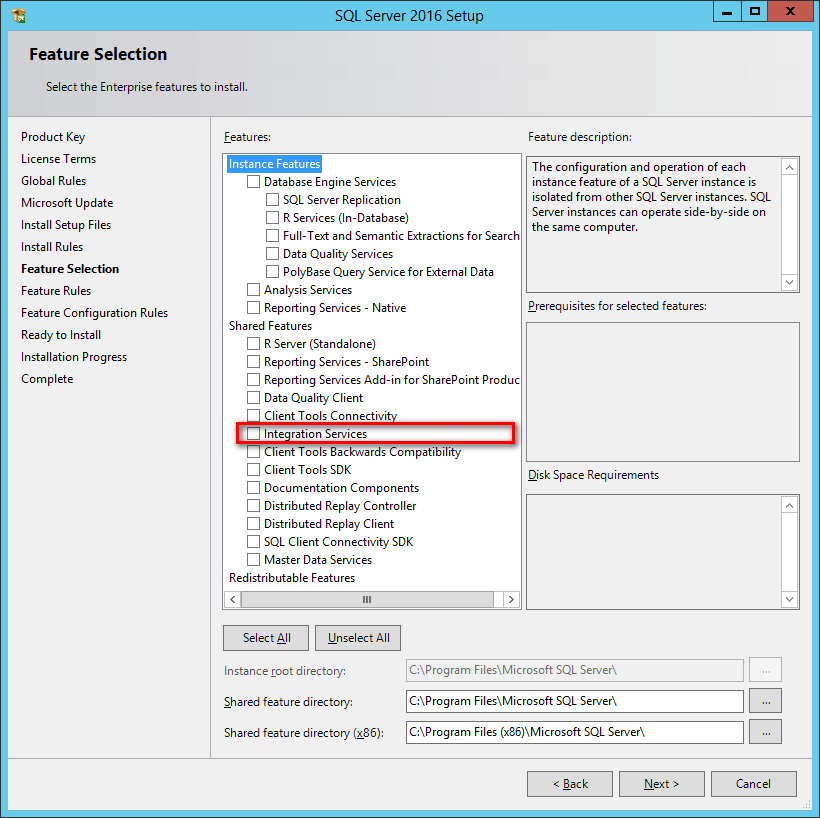
Note that when using SQL Server 2014, a cumulative update (preferably a recent service pack) is required to run our software during runtime. Otherwise, you may encounter some general .NET errors.
- Design-time
- For SSIS design-time, you should install the following:
- The latest version of SQL Server Integration Services Projects Extension
- A supported Visual Studio version, such as Visual Studio 2026 or 2022
Note that Visual Studio should be first installed before installing the SSIS Project Extension. In addition, it is possible to work with an older version of the SSDT installation if you have saved a copy of the original download. However, we generally recommend using the latest SSIS Project Extension and a recent Visual Studio installation for best compatibility.
- Windows Operating System
- Windows operating system requirements largely depend on the version of the SSIS runtime or design-time selected. We don't have any additional requirements in terms of the Windows operating system as long as it satisfies the minimum requirements of the SSIS runtime or design-time. The general guideline is that newer versions of the operating system tend to perform better. In summary, our software is compatible with the following Windows operating systems:
-
For desktop systems (mostly for development workstations)
- We generally recommend Windows 11 or greater.
- Earlier versions of Windows desktop systems, such as Windows 10, 8.1, 8, or 7, should typically work if the general prerequisites are met. However, these versions are generally not recommended due to their support status with Microsoft.
- We generally recommend Windows 11 or greater.
-
For server systems (mostly for runtime deployments)
- We generally recommend Windows Server 2019 or greater (including Windows Server 2022, Windows Server 2025, and potentially future Windows Server versions).
- Earlier versions of Windows Server operating systems, including Windows Server 2016 and Windows Server 2012, should work properly provided they satisfy the minimum requirements of the .NET Framework installation mentioned below. Please be mindful that those two versions are either approaching or have already reached their respective extended support, also known as end-of-life support.
- We generally recommend Windows Server 2019 or greater (including Windows Server 2022, Windows Server 2025, and potentially future Windows Server versions).
-
For desktop systems (mostly for development workstations)
- .NET Framework
-
- Our software requires the installation of .NET Framework 4.7.2 or above (including .NET Framework 4.8).
When you have confirmed that your system satisfies the necessary prerequisites, you can navigate to KingswaySoft's website at https://www.kingswaysoft.com to download the installation package.
After downloading the package, you can install the software by following the installation wizard.
Working with the SSIS Toolbox
SSIS Toolbox is the first place that you will be looking for our components to be added to your ETL process during the design time.
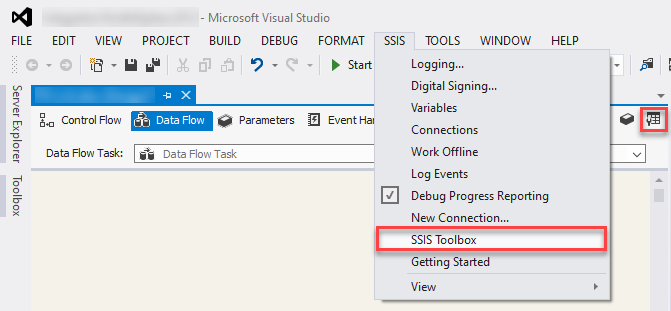
Note: When working with SSIS Toolbox, you need to make sure that you are in the right view in order to see the right components. For instance, if you are looking for a data flow component, you need to make sure that you are in the Data Flow view, not the Control Flow view. Visual Studio would show different components depending on the design view that you are currently working with.
Once the data flow components are available in the SSIS Toolbox, you can start your ETL development by dragging them from the toolbox to the Visual Studio design surface.
Assigning Permissions
The QuickBooks Connection Manager retrieves tokens from the QuickBooks app, once you give authorization. These tokens are then stored in the Registry so that once they have expired, our component will automatically request new tokens from QuickBooks to minimize user effort, and replace the existing tokens with these new ones in Registry. In order to achieve this, there must be proper permissions given to the KingswaySoft folder in Registry.
Start by opening the Registry Editor, and navigate into the following folders:
- HKEY_LOCAL_MACHINE > SOFTWARE > KingswaySoft > SSIS Integration Toolkit for QuickBooks

- Right-click on the SSIS Integration Toolkit for QuickBooks in the KingswaySoft folder and select the Permissions option. Enable the following permissions to give yourself permission to modify this folder.
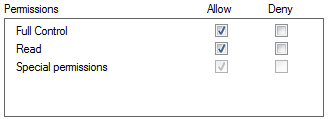
Using the QuickBooks Connection Manager
SSIS Integration Toolkit for QuickBooks includes an SSIS Connection Manager component to help you establish connections to QuickBooks web services.
To add a new QuickBooks connection to your SSIS package, right-click the Connection Manager area, and choose "New Connection..." from the context menu.
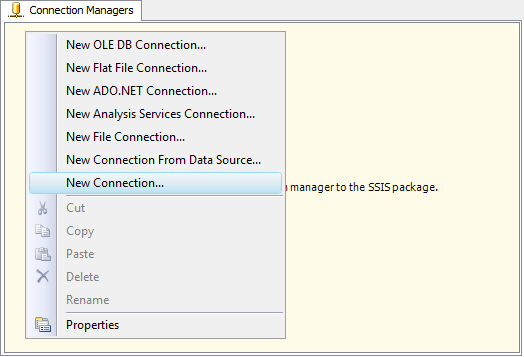
You will be prompted the "Add SSIS Connection Manager" window, where you can select "QuickBooks (KingswaySoft)" and click "Add..." to create the connection.
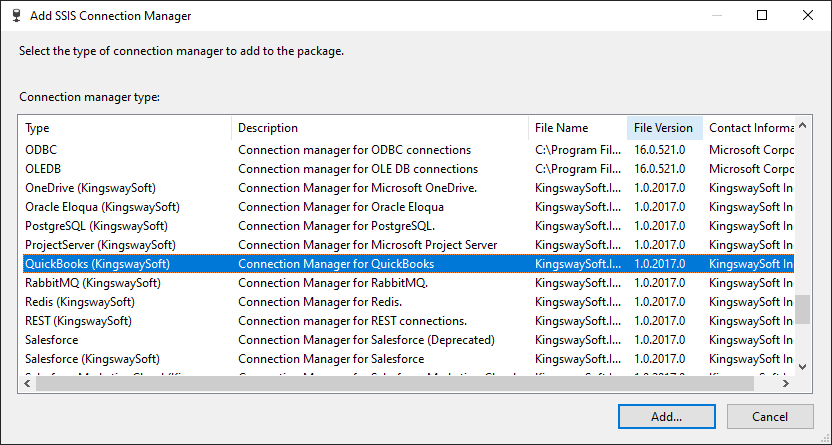
The QuickBooks Connection Manager contains the following tabs:
- General
- Advanced Settings
- More Info
General Page
The General tab of the QuickBooks Connection Manager allows you to specify connection string settings. It supports connections to both QuickBooks Online and QuickBooks Desktop. In order to connect to QuickBooks for Desktop, the QuickBooks Desktop Gateway needs to be installed and running on the machine running QuickBooks for Desktop.
- Deployment
-
The Deployment option allows you to specify what type of QuickBooks instance you want to connect to. There are two options available:
- Online instance
- Desktop instance
- Note that when using the Desktop connection, you need to make sure that the QuickBooks Gateway program is installed on the computer where you have QuickBooks installed, and you need to make sure the program and the service have been started. Please refer to the Using the QuickBooks Desktop Gateway section for instructions on how to install QuickBooks Desktop Gateway.
- Deployment - Online
-
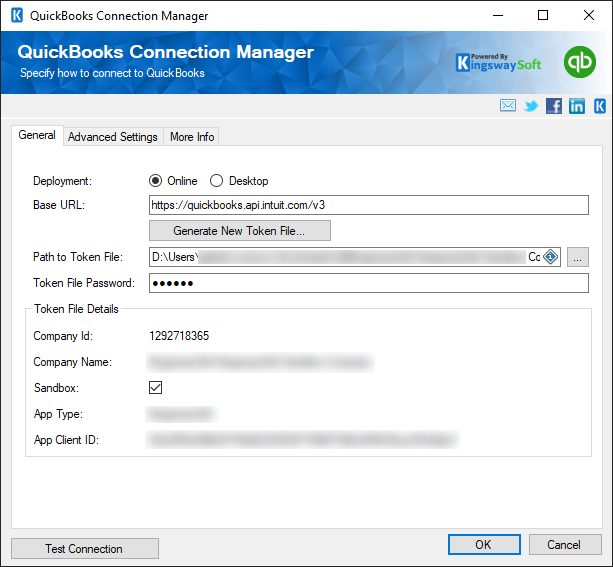
- Generate New Token File
-
This button will open a dialog in order to generate a new Token File.

- Instance Type: This option allows you to specify if you want to connect to your Sandbox instance or your production instance.
-
App Type
-
KingswaySoft: The Connection Manager will use the Client Id and Secret that is provided by KingswaySoft for your convenience when setting up the connection. It is important to note that this app is provided for convenience, we generally don't recommend you use this app for production use.
- Note: The KingswaySoft Shared OAuth App is no longer recommended and may be subject to API errors due to limits imposed by platform. Please refer to our blog post (link here) for more details and action required if you are already using this App type. A warning will be shown if you are using our version 25.2 and above.
- My Own App: Selecting this option will allow you to use your own Client ID and Secret to connect to QuickBooks. To create your own app, you can log in to the QuickBooks developer portal to create from there. We generally recommend you use this option for better security and better control over the app itself.
-
KingswaySoft: The Connection Manager will use the Client Id and Secret that is provided by KingswaySoft for your convenience when setting up the connection. It is important to note that this app is provided for convenience, we generally don't recommend you use this app for production use.
- Client ID: The Client Id option allows you to specify the unique ID which identifies the application making the request.
- Client Secret: The Client Secret option allows you to specify the client secret belonging to your app.
- Redirect URI: The Redirect Url option allows you to specify the Redirect Url which was assigned to your app.
- Scope: The scope that your app will need access to.
- Use Default Browser to Sign In: When this option is checked the Sign In and Authorize button will open your default web browser in order to complete the OAuth authentication. When this option is unchecked, the Sign In and Authorize button will complete the entire OAuth authentication process inside of the toolkit.
- Sign In and Authorize: This button allows you to log in to the service endpoint and authorize your app to generate a token.
-
Signed In Account Details
- Company ID: Displays the QuickBooks Company ID which the token file was created for.
- Company Name: Displays the QuickBooks Company Name which the token file was created for.
- Password: This option allows you to assign a new password for the token file which will be created.
- Save To Token File: This option allows you to specify the location of where the token file will be saved.
- Path to Token File
-
This option allows you to specify the path to the token file on the file system. This option supports both file system paths as well as Azure Blob Storage Shared Access Signature (SAS) URLs. Please note that you would need to write permission when specifying the URL.
- Token File Password
-
This option allows you to specify the password of the selected token file.
- Token File Details
-
- Company ID: Displays the QuickBooks Company ID which the token file was created for.
- Company Name: Displays the QuickBooks Company Name which the token file was created for.
- Sandbox: Displays the instance type the token file was created for.
- App Type: Displays the client application Type with which the token file was created.
- App Client ID: Displays the client application ID which the token file was created with.
- Deployment - Desktop
-
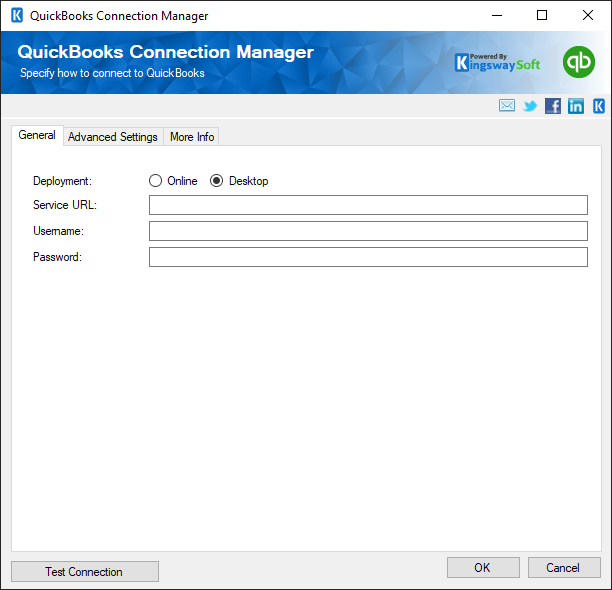
- Service URL
-
The Service URL field allows you to connect to the QuickBooks Desktop Gateway. A Service URL is made up of the machine name or IP address along with the configured port number. ex: http://MyQuickBooksMachineName:7777.
- Username
-
The Username field is used to connect to the QuickBooks Desktop Gateway as a particular user. On the QuickBooks Desktop Gateway, you can associate users to company files on the machine. This allows you to differentiate connections to different company files on the same machine.
- Password
-
The Password field is used to authenticate the QuickBooks Desktop Gateway user.
- Test Connection
-
After all the connection information has been provided, you may click Test Connection to test if the user can successfully authenticate with QuickBooks.
Advanced Settings Page
The Advanced Settings tab of QuickBooks Connection Manager allows you to specify some advanced and optional settings for the connection.
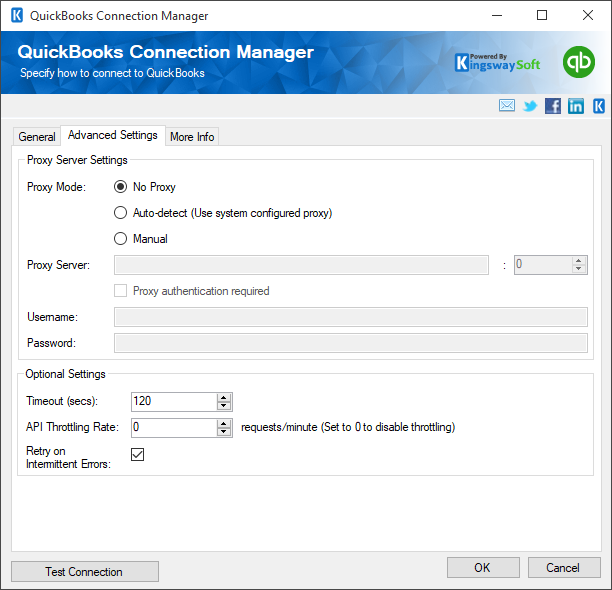
- Proxy Mode
-
The Proxy Mode option allows you to specify how you want to configure the proxy server setting. There are three options available.
- No Proxy
- Auto-detect (Using system-configured proxy)
- Manual
- Proxy Server
-
Using the Proxy Server option, you can provide a proxy server to connect to QuickBooks.
- Port
-
The Port option allows you to specify the port number of the proxy server for the connection.
- Username
-
The Username option allows you to specify the proxy user account.
- Password
-
The Password option allows you to specify the proxy user’s password.
Note: Proxy Password is not included in the QuickBooks connection manager's ConnectionString property by default. This is done by design for security reasons. However, you can include it in your ConnectionString if you want to parameterize your connection manager. The format would be ProxyPassword=myProxyPassword; (make sure you have a semicolon as the last character). It can be anywhere in the ConnectionString.
- Timeout (secs)
-
The Timeout (secs) option allows you to specify a timeout value in seconds for the connection. The default value is 120 seconds.
- API Throttling Rate (requests/sec)
-
The API Throttling Rate will limit the number of requests that can be sent per hour. Set this value to 0 to disable API Throttling.
- Retry on Intermittent Errors
-
This is an option designed to help recover from possible intermittent outages or disruption of service. It prevents the integration process from stopping due to temporary issues. Enabling this option will allow service calls to be retried upon certain types of failure. A service call may be retried up to 4 times at different intervals before an exception is fired.
Warning: We have designed our retry feature carefully such that the retry should only occur when it is deemed safe to do so; however, in some occasions, such retry service calls could result in the creation of duplicate data, we believe this would only happen in extreme situations.
More Info Page
The More Info page shows some basic information about where to find support and additional information about the toolkit. On this page, you can find the version information of the toolkit.
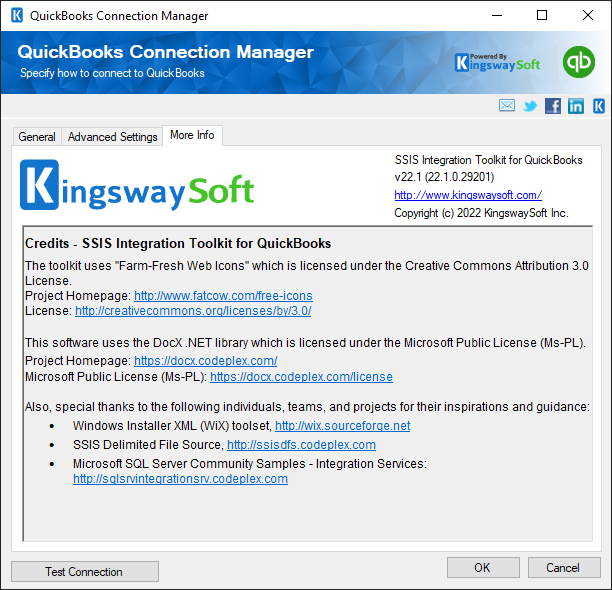
Using the QuickBooks Source Component
The QuickBooks Source Component allows you to read data from QuickBooks. The component allows you to specify a source entity to read from and filter for desired records.
General page
The General page is where you will configure most of the setup details.
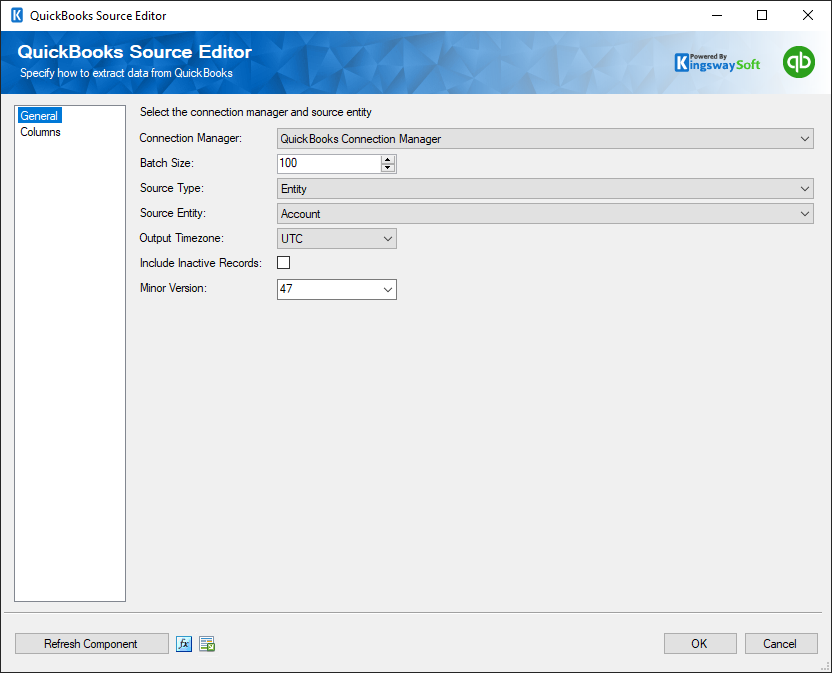
- Connection Manager
-
The QuickBooks source component requires an active connection to QuickBooks Online or QuickBooks Desktop Gateway. You can specify a Connection Manager here to facilitate that connectivity.
- Batch Size
-
The Batch Size lets you specify how many records to retrieve per service call.
- Source Type
-
You can specify how you would like to retrieve data from QuickBooks Online. There are 3 options, Entity, Query, or Change Data Capture. This option is not available for QuickBooks Desktop connections as it will always use Entity.
- Source Entity
-
If you chose Entity for the Source Type drop-down (Or are using a QuickBooks Desktop connection), you can specify which entity to read from the Source Entity drop-down.
- Output Timezone
-
This option allows you to specify the output timezone setting when reading from QuickBooks. There are two options available:
- UTC
- Local Time
- Include Inactive Records
-
If you chose a Name list entity (e.g. Customer) from the Source Entity drop-down, the Include Inactive Records checkbox is revealed. This option lets you retrieve records that have been Soft Deleted (Active field set to false). This option is only available for QuickBooks Online connections.
- Minor Version
-
This option allows you to choose the API Minor version you want to use from a drop-down list
- QuickBooks Query
-
If you chose Query for the Source Type drop-down, you can specify a QuickBooks query to read data from.
If you have an Intuit Developer account, you may want to read the Querying data documentation. This option is only available for QuickBooks Online connections.
- QBXML Options
-
The QBXML option allows you to specify a QBXML filter string to only retrieve data that meets specified criteria. For example, using the <FromModifiedDate> and <ToModifiedDate> filters to query for objects modified during a specified range of dates. The best place to find further information on QBXML is to refer to the Creating Queries Chapter of the Intuit QuickBooks Programmer's Guide. This option is only available for QuickBooks Desktop connections. Please note that the value provided to this property should be in XML format such as shown below:
<IncludeLineItems>true</IncludeLineItems> <IncludeLinkedTxns >true</IncludeLinkedTxns>
Utilizing the Child Entities Output of the Source Component
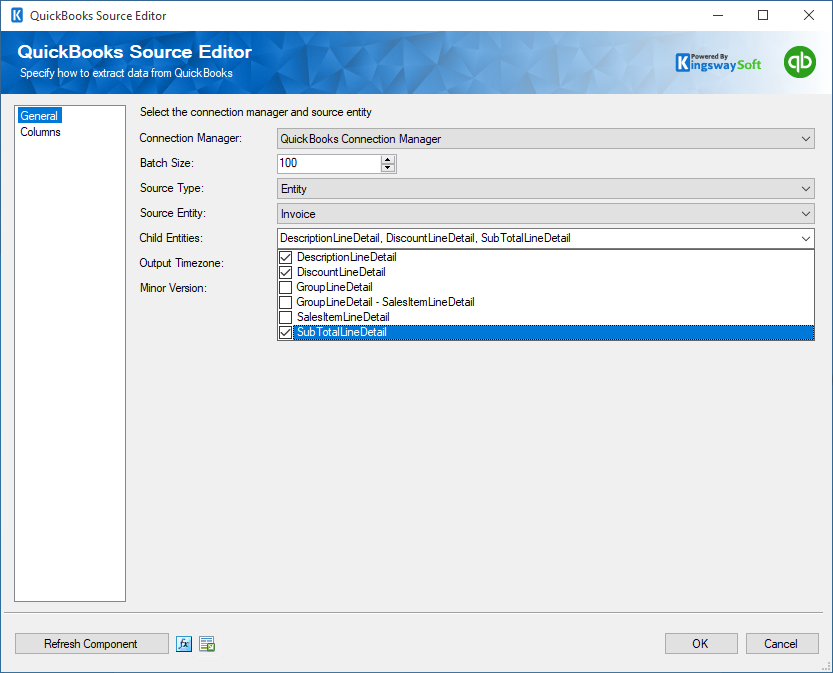
In QuickBooks, some entities have child entities. If a source entity has child entities they will appear as entities in the Child Entity combo box, and you can select any you wish to output. Each child entity that is selected will add an additional output to the QuickBooks Source component, as well as additional fields related to the child entities checked.
Columns Page
The Columns page lists all the available metadata fields for the entity that you wish to read from.
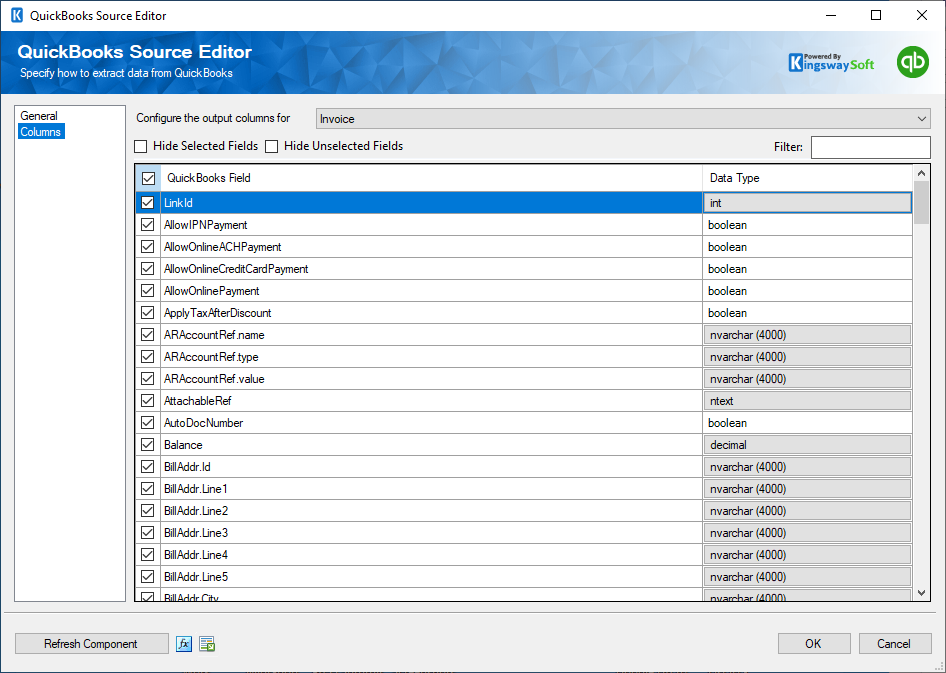
Using the QuickBooks Destination Component
The QuickBooks Destination Component is an SSIS data flow pipeline component that can be used to write data to QuickBooks Online. You may Create, Update, and Delete records with this component.
General Page
The General page of the QuickBooks Destination Component allows you to specify the general settings of the component.
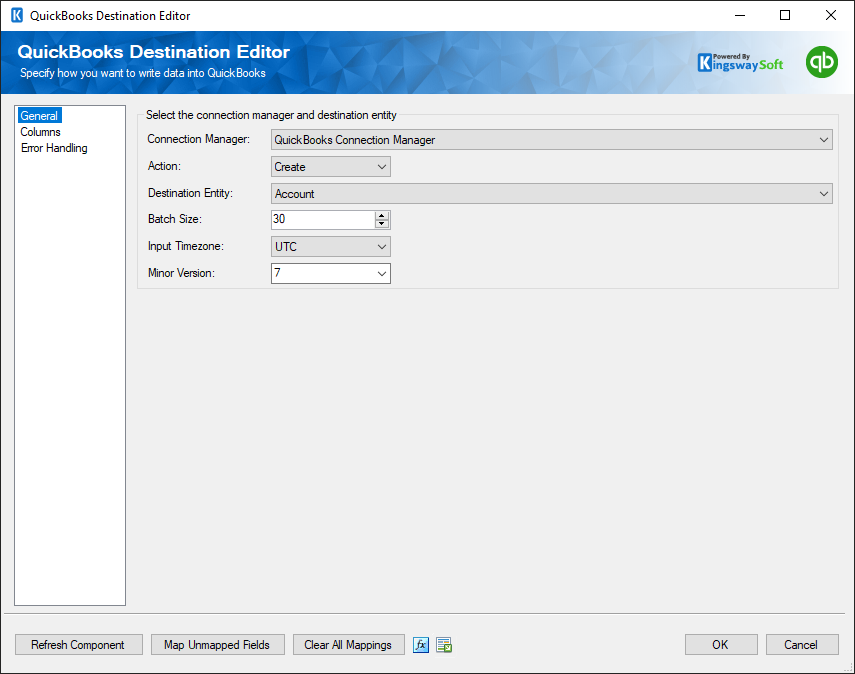
- Connection Manager
-
The QuickBooks destination component requires an active connection to QuickBooks. You can specify a Connection Manager here to facilitate that connectivity.
- Action
-
The Action option allows you to specify how the data should be written into QuickBooks, there are different action types available depending on what instance type of your QuickBooks system is.
- For QuickBooks Online instance, there are four (4) action types available:
- Create: Create new record(s) in QuickBooks Online
- Update: Update existing record(s) in QuickBooks Online
- HardDelete: Hard Delete record(s) from QuickBooks Online
- SoftDelete: De-Activates record(s) from QuickBooks Online
- For QuickBooks Desktop instance, there are four (4) action types available:
- Create: Create new record(s) in QuickBooks Desktop
- Update: Update existing record(s) in QuickBooks Desktop
- Delete: Delete record(s) from QuickBooks Desktop
- Void: Void record(s) in QuickBooks Desktop
- For QuickBooks Online instance, there are four (4) action types available:
- Destination Entity
-
The Destination Entity option allows you to specify which QuickBooks entity to write data to. A drop-down with available entities is listed here.
- Batch Size
-
The Batch Size allows you to specify how many entities should be written to from a single service call. For example, when working with QuickBooks online instance, it has a maximum limit of 25 batched operations per service call.
- Input Timezone
-
This option allows you to specify the input timezone setting when writing to QuickBooks. There are two options available:
- UTC
- Local Time
- Minor Version
-
This option allows you to choose the API Minor version you want to use from a drop-down list
- Refresh Component button
-
By clicking this button, the component will retrieve the latest metadata from QuickBooks' web services. After clicking this button, you will receive a status message indicating how many fields have been updated, added, or deleted.
- Map Unmapped Fields button
-
By clicking this button, the component will map any unmapped fields by matching their names with the input columns from the upstream component. This is useful when your source component has recently added more columns, in which case you can use this button to automatically establish associations between input columns and unmapped fields.
- Clear All Mappings button
-
By clicking this button, the component will remove all field mappings. You can use this button to reset your mappings.
Hard Delete vs Soft Delete
A Hard Delete can be performed on QuickBooks Transaction entities (e.g. Invoice). A Hard Delete will permanently delete the record. If you attempt to perform a Hard Delete and get an Operation Delete is not Supported error message, it means that the entity you specified does not support a hard delete operation. Most likely it is a Name list entity that you are attempting to hard delete.
A Soft Delete can be performed on QuickBooks Name list entities (e.g. Customer). A Soft Delete essentially performs an update on the record to set the Active field to false. If you attempt to perform a Soft Delete and get a Property Name: Unrecognized field "Active" error message, the entity that you are trying to soft delete does not contain a field called Active, and therefore cannot be soft deleted. Most likely it is a Transaction entity that you are attempting to soft delete.
Utilizing the Child Input of the Destination Component
If you want to write child entity data to a QuickBooks entity, you can connect an inbound component containing child entity data to the secondary inputs. Once you have made a connection to a Secondary Input, you must specify the Child Entity you are adding in the Child Setting grid on the General page.
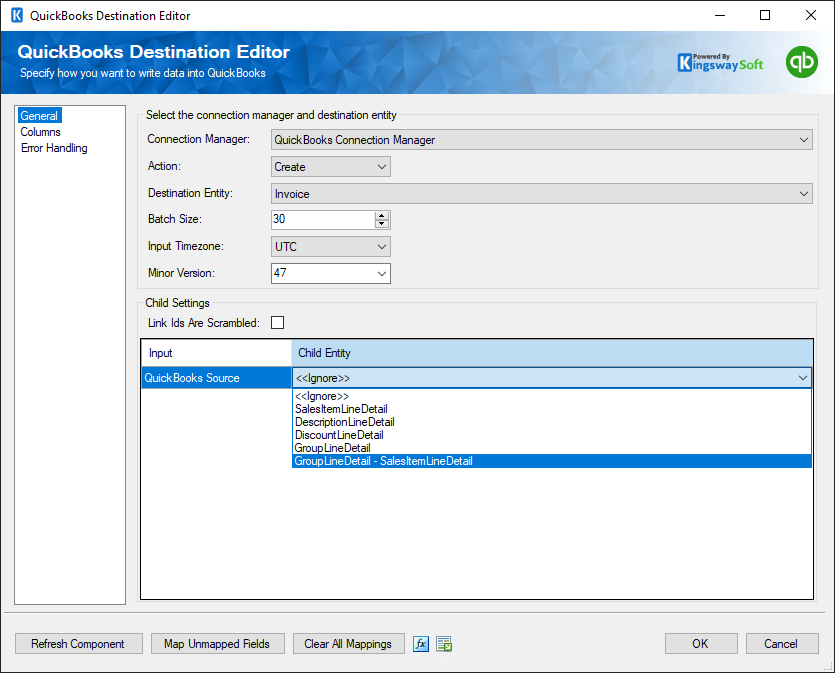
When a child is mapped in the Child Settings grid on the General page, it will be available in the select input drop-down on the Columns page. This allows for selecting input for both parent and child fields. The parent input (Primary Input) will have a field called _LinkId which can be any string and is used to link the parent to its child object. All child inputs (Secondary Inputs) will have a field called _ParentLinkId. This field should have a value that matches the value used for the _LinkId of the parent.
Note: Each input must be sorted; for the primary input sort by the _LinkId field, and for secondary inputs sort by the _ParentLinkId field.
Columns Page
The Columns page of the QuickBooks Destination Component allows you to map the columns from upstream components to fields for the destination entity.
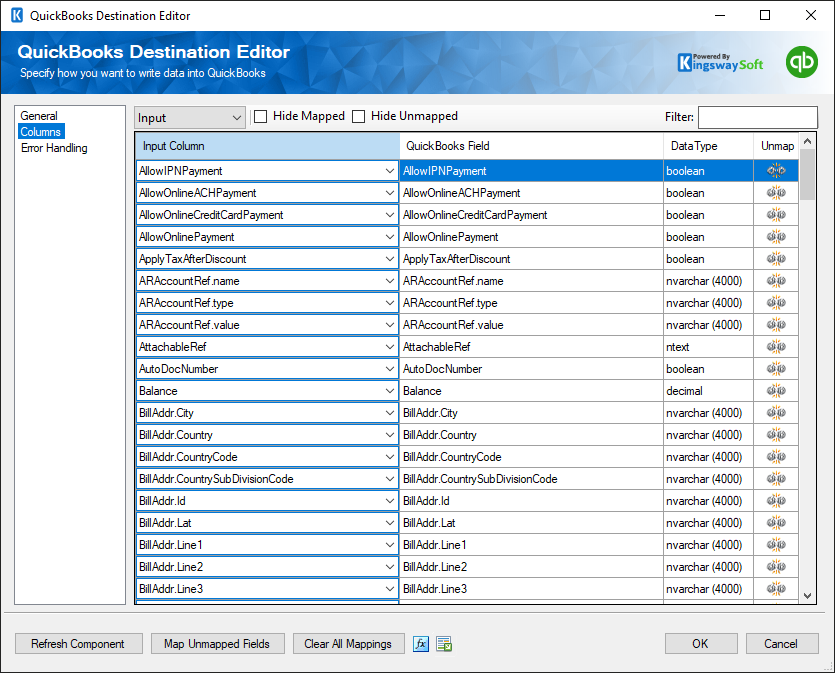
On the Columns page, you will see a grid with four columns as seen above.
- Input Column: You can select a column from your upstream component to be used as the input of the corresponding field.
- QuickBooks Field: The field that you are writing data.
- Data Type: This column indicates the type of value for the current field in QuickBooks. Typically you would need to pass in the value using the format indicated in the Data Type column.
- Unmap: This column can be used to unmap the field from the upstream input column, or otherwise it can be used to map the field to an upstream input column by matching its name if the field is not currently mapped.
Error Handling Page
The Error Handling page allows you to specify how errors should be handled when they happen.
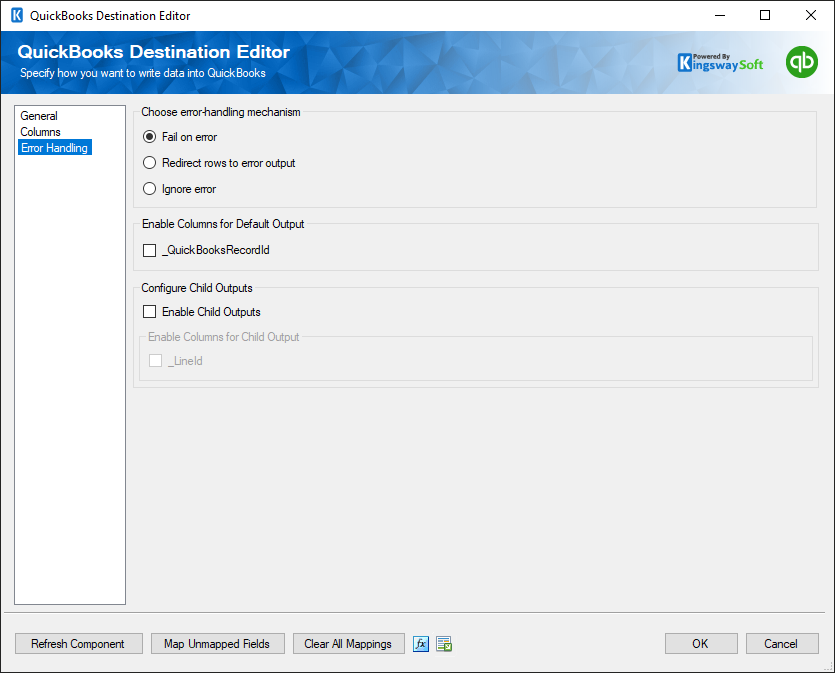
There are three options available:
- Fail on error
- Redirect rows to error output
- Ignore error
When the Redirect rows to error output option is selected, rows that failed to write to QuickBooks will be redirected to the 'Primary Error Output' of the Destination Component. The 'ErrorMessage' output column found in the Error Output may contain the error message that was reported by QuickBooks or the component itself.

Note: Use extra caution when selecting Ignore error option, since the component will remain silent for any errors that have occurred.
On the Error Handling page, there is also an option that can be used to enable or disable the following output field for the destination component.
- _QuickBooksRecordId: contains the newly created QuickBooks record's ID, which you can use to write to log or further process using additional data flow components.
- Enable Child Outputs: This option will enable the child outputs if there is a secondary input attached to the child lines. This output would be named {childentityname} Output.
- _LinkId: If this option is enabled, the child link id would be available in the child output.
Using the QuickBooks Desktop Gateway
The QuickBooks Desktop Gateway is a utility used to bridge the gap between SSIS and QuickBooks for Desktop (on-premises). This is done by installing the QuickBooks Desktop Gateway on the machine running QuickBooks Desktop and then connecting to it with the QuickBooks Connection Manager using "Desktop Deployment" settings.
Note: To install the QuickBooks Desktop Gateway, download and install the Integration Toolkit and select "QuickBooks Desktop Gateway" as the Setup Type during installation. After the installation is complete, version 16 of QBFC (The QuickBooks SDK) will be installed on the machine as well. This is a mandatory component for the QuickBooks Desktop Gateway to function. If it fails to install or you wish to uninstall the SDK, you can manually run the installer "C:\Program Files\KingswaySoft\SSIS Integration Toolkit for QuickBooks\QBFC16_0Installer.exe". Note that you might be working with a different SDK version if you are working with a prior version of the QuickBooks toolkit.
The QuickBooks Desktop Gateway has 3 pages of settings:
- General
- Security
- Advanced
The settings for the QuickBooks Desktop Gateway are saved in a file by the name of "QbDesktopGatewayByKingswaySoft.conf" in the same directory as the gateway executable. After configuring the settings, use the "Start", "Stop", and "Restart" buttons to manage the gateway.
General Page
The General page allows you to specify general connection properties to QuickBooks Desktop.
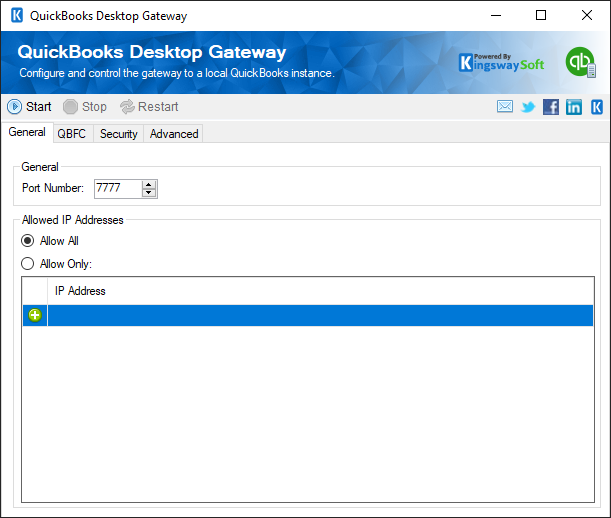
- Port Number
-
The Port Number option allows you to specify the port number of the QuickBooks server.
- Allow IP Addresses
-
The Allow IP Addresses option allows you to specify the IP Addresses of the users who are allowed to connect to the QuickBooks server.
QBFC page (since v21.1)
The QBFC page allows you to specify the additional QBFC SDK options to open a connection and begin a session.
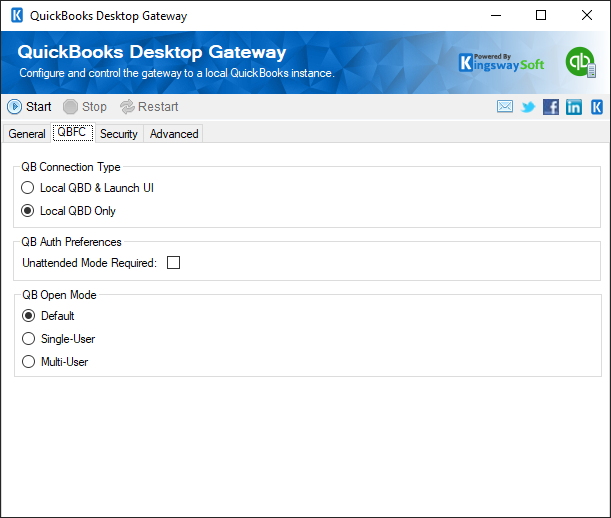
- QB Connection Type
-
The QB Connection Type allows you to specify the connection type when opening the connection, the available options are:
- Local QBD & Launch UI: This option tells the request processor to connect to a local QuickBooks and then request that the local copy of QuickBooks start up its user interface and prompt for the user to log in.
- Local QBD Only: This option tells the request processor to connect to QuickBooks running locally (i.e. on the same machine as the request processor and the client application).
- QB Auth Preferences
-
There is an Unattended Mode Required option available in QB Auth Preferences. Setting the option to False to indicate that the application does not require unattended mode; the authorization dialog will display the three default authorization options and let the administrator choose from them (including the option to allow unattended mode). Enable the "Unattended Mode Required" option to indicate that the application requires unattended mode to function properly; the authorization dialog will display only two choices, Yes, allow access even if QuickBooks is not running, which authorizes unattended mode, and No, which declines any authorization for the application.
- QB Open Mode
-
The QB Open Mode parameter indicates whether the application is requesting access to the company file in single-user mode or multi-user mode. There are three options available:
- Default: The Default option allows for either multi-user or single-user mode, depending on whether the company file is currently open or not.
- Single-User
- Multi-User
Security Page
The Security page allows you to specify security properties to QuickBooks Desktop.
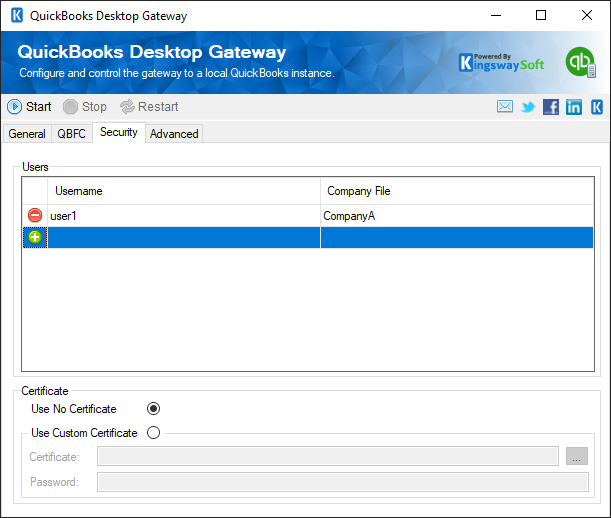
- Users
-
The Users grid allows you to add and remove users. When adding a new user, you have the option to associate a QuickBooks company file with this user. If no company file is specified then the user will access whatever company file is open at the time of the request. This makes differentiating connections to different company files on the same machine possible while adding an additional layer of security.
- Certificate
-
To enable https you will need to use a custom certificate and provide a path to the certificate file along with the password.
Advanced Page
The Advanced page allows you to specify advanced connection properties to QuickBooks Desktop.
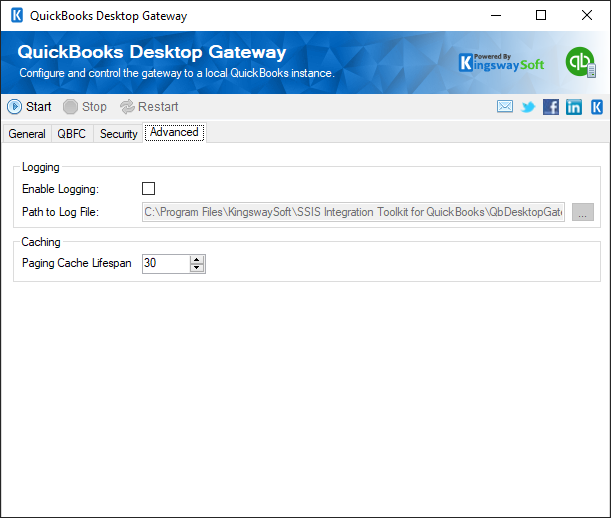
- Enable Logging
-
When enabled, this option will log requests made to the QuickBooks Desktop Gateway and log them in the file specified by Path to Log File.
- Path to Log File
-
The file to log requests to.
- Paging Cache Lifespan
-
This option is used for reading operations on that page. It specifies how long the nextPageTokens and the block of records they point to will be available in minutes.
Using the QuickBooks Token Manager
Note: Our QuickBooks Token Manager has been deprecated and can only be used to migrate tokens saved by older versions to the new file format.
The QuickBooks Token Manager is a utility external to SSIS that allows you to add, remove, import, and export your QuickBooks Tokens from machine to machine.
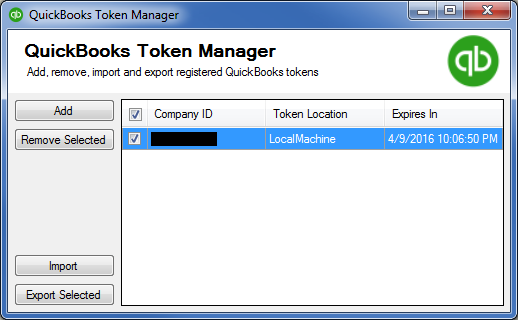
Once you have developed your integration package, and you are getting ready to deploy, this utility will assist you in getting your QuickBooks tokens from your development environment to your integration server:
- Open the QuickBooks Token Manager on your development machine
- Select the tokens you wish to export
- Click the 'Export' button
- Save the 'tokens.json' file
- Move the file manually to your integration server
- Open the QuickBooks Token Manager on your integration server
- Click the 'Import' button
- Select the 'tokens.json' file
This is the simplest way to get your tokens from your development environment to your integration server but in some cases, you may need to add tokens manually, in which case simply click the 'Add' button. Adding tokens in the QuickBooks Token Manager is exactly like adding tokens in the QuickBooks Connection Manager.
You may also need to remove tokens from your machine. Simply select the tokens you wish to remove and click the 'Remove' button.
Overall the QuickBooks Token Manager is a simple and secure utility that helps make your integration easy and safe.
Note: As of Version 20.1.0, we have switched to using token files instead of relying on the Windows registry for managing tokens due to better security and easier deployment. If you have old tokens available, and if you wish to switch them to token files, select each token and click on the Export Selected button to export the tokens as token files.
License Manager
SSIS Integration Toolkit comes with a license manager program that helps you manage and activate the product license key to be used for the toolkit. The below information is useful for development workstations and Single Server license management. For Azure-SSIS IR deployments, license management and activation will be handled through the PowerShell script, see Running SSIS Integration Toolkit on the Cloud for further details.
Without a commercial license, SSIS Integration Toolkit will operate under the Developer License which is free to use for development or evaluation purposes. Under the developer license, you can use the software within the development tool (SSDT-BI, BIDS, or Visual Studio).
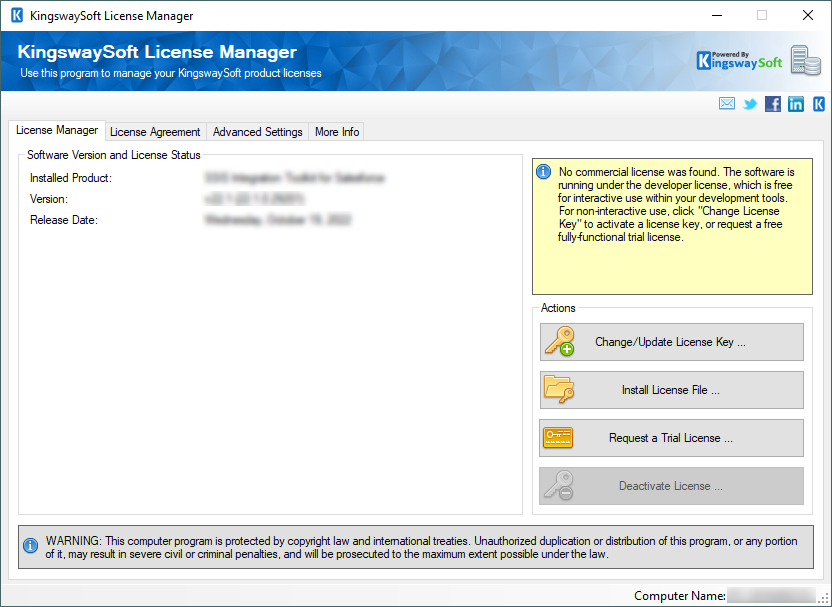
The only limitation of the free developer license is the inability to run the software outside of the development tool (SSDT-BI, BIDS, or Visual Studio). If you would like to run the software outside the development tool, such as running SSIS packages on a scheduled basis or from a command line, you will need to acquire a license from us.
If you want to test out the functionality by scheduling your SSIS packages, a trial license can be requested. To do so, you can launch the License Manager program, then click the "Change/Update License Key..." button, where you can request a free trial license after filling out the necessary Licensee Information.
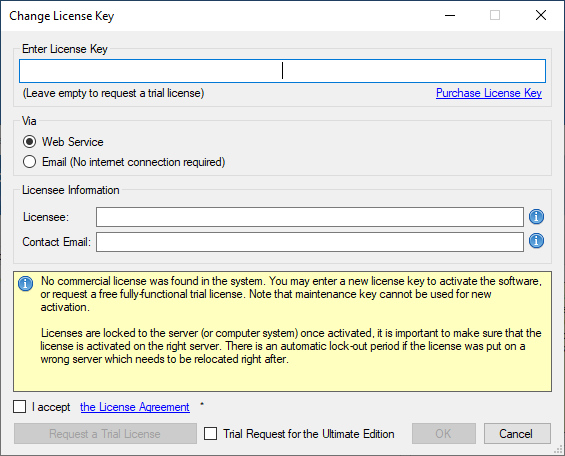
If you have received a product license key from us after placing an order through our online shopping cart system, you can also click the "Change/Update License Key..." button and enter the product license key in order to activate the software to use the fully-featured commercial license.
The Licensee field is where you will specify the company the software is licensed to, you can include your system's machine name for future reference. For example, the Licensee can be "ABC Inc." or "XYZ Corp (SQLSVR-001)." The Contact Email would be the person we reach out to for any license-related notices such as renewal reminders.
To request a free trial license or activate a product license key that you have received, you can use the Web Service option to complete the process by sending the request to our license server directly. An Internet connection is required when the Web Service option is used. This is the option that we recommend.
Alternatively, you can choose the Email option so that the license manager will generate an email for you which you can send to us. The Email option should only be used if your system has no Internet access. It requires manual processing so please expect to wait for 24 to 48 hours before receiving a license file from us. Once you have received the license file from us through email, you can save it to a local file, which you can then install by clicking the "Install License File..." button in License Manager.
If you have acquired a license from us, once the software has been activated, your license manager should look as shown below:
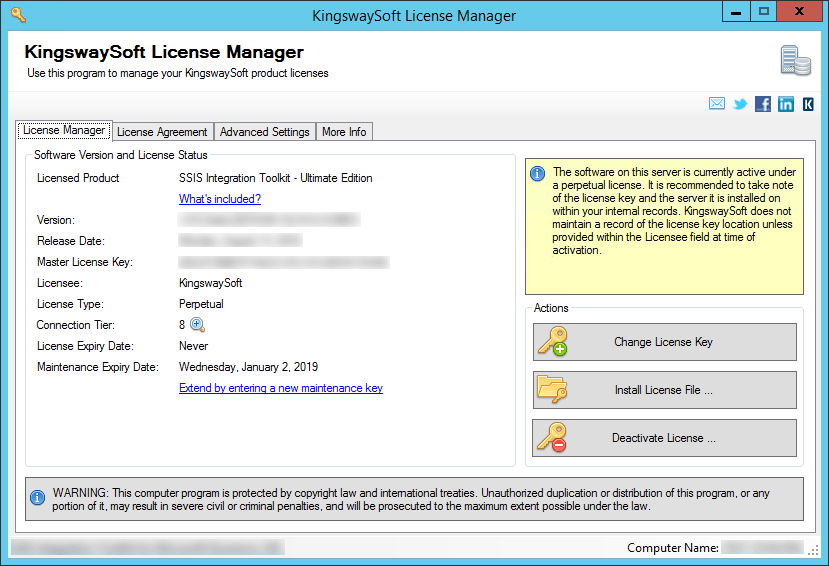
Connection Tier will display the number of distinct connections your license supports per connection type within a 24-hour period at runtime. Multiple connections to the same instance are typically treated as 1 distinct connection (exceptions may apply depending on the nature of the service). Selecting the magnify icon will launch the Runtime Connection Usage Summary window which will display counts on the number of connections made per connection type and when the 24-hour period will reset.
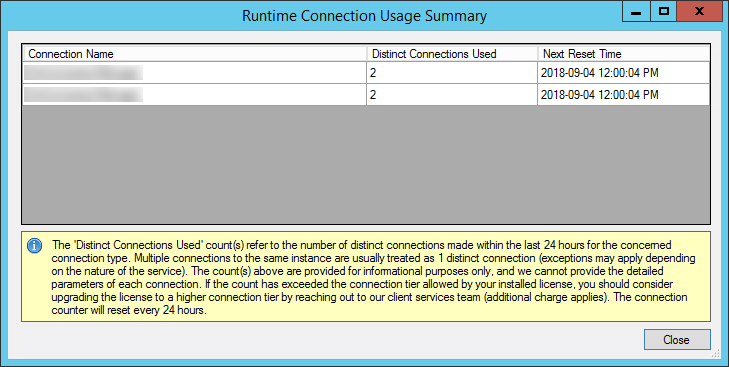
If you own a perpetual license from us, you should be able to see your Maintenance Expiry Date in the License Manager program. By default, your perpetual license should be instated with a one-year maintenance and upgrade included, which entitles you to use any version of the software released before your Maintenance Expiry Date. To extend your software license maintenance, log in to our portal and navigate to the license key using the License Keys menu. From there, you can renew the license or otherwise reach out to our Client Services team to request their assistance in renewing your license terms.
Note: Perpetual license is only applicable to clients who have previously acquired such a license before the deprecation of the license type. It is no longer offered for any new purchases.
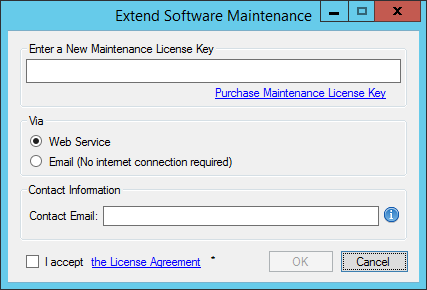
If your commercial license is a subscription license, you will not see the Maintenance Expiry Date option in the License Manager program, since your subscription license comes with maintenance and upgrade for the entire subscription period. Instead, you will see your license expiry date and a progress bar with the number of days left on your subscription.
Note: You must run the License Manager program under a local administrative account due to the privileges required to write license files to the system.
Contact Us
If you need any further assistance with the toolkit, please don't hesitate to contact us.


